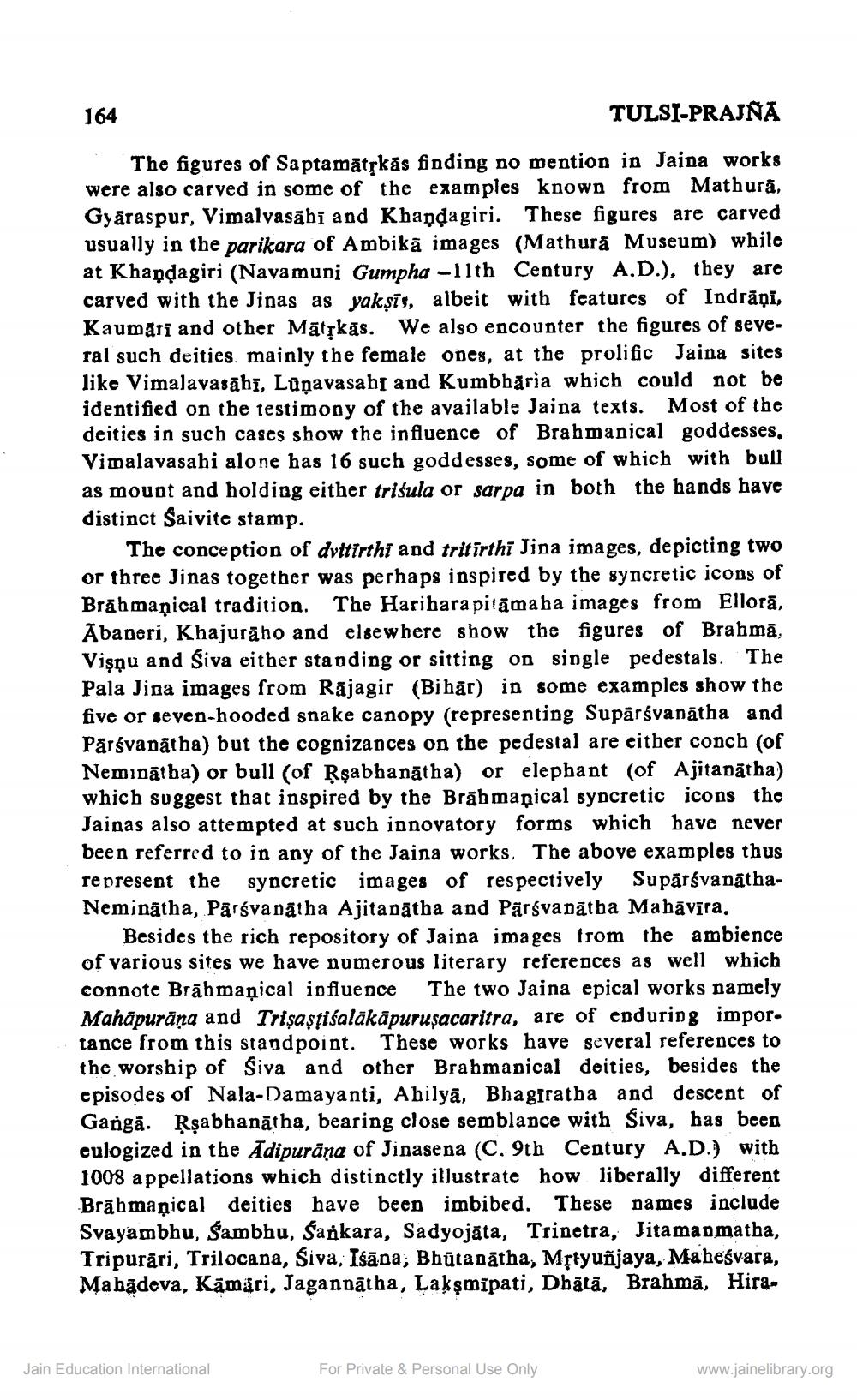________________
164
TULSI-PRAJNA
The figures of Saptamātýkās finding no mention in Jaina works were also carved in some of the examples known from Mathurā, Gyaraspur, Vimalvasābi and Khaņdagiri. These figures are carved usually in the parikara of Ambikā images (Mathura Museum) while at Khapdagiri (Navamuni Gumpha -11th Century A.D.), they are carved with the Jinas as yakṣīs, albeit with features of Indrāņi, Kaumari and other Mātrkās. We also encounter the figures of several such deities, mainly the female ones, at the prolific Jaina sites like Vimalavasāhī, Lūnavasabi and Kumbharia which could not be identified on the testimony of the available Jaina texts. Most of the deities in such cases show the influence of Brahmanical goddesses. Vimalavasahi alone has 16 such goddesses, some of which with bull as mount and holding either trisula or sarpa in both the hands have distinct Saivite stamp.
The conception of dvitirthi and tritirthi Jina images, depicting two or three Jinas together was perhaps inspired by the syncretic icons of Brāhmaṇical tradition. The Haribara pilãmaha images from Ellorā, Ābaneri, Khajurāho and elsewhere show the figures of Brahmā, Vişnu and Siva either standing or sitting on single pedestals. The Pala Jina images from Rājagir (Bihár) in some examples show the five or seven-hooded snake canopy (representing Supärsvanātha and Pārsvanatha) but the cognizances on the pedestal are either conch (of Neminātha) or bull (of Rşabhanātha) or elephant (of Ajitapātha) which suggest that inspired by the Brāhmapical syncretic icons the Jainas also attempted at such innovatory forms which have never been referred to in any of the Jaina works. The above examples thus represent the syncretic images of respectively SupārsvanāthaNeminātha, Pārsvanātha Ajitanātha and Pārsvadātba Mahāvīra,
Besides the rich repository of Jaina images from the ambience of various sites we have numerous literary references as well which connote Brāhmaṇical influence The two Jaina epical works namely Mahāpurāna and Trisasțisalākāpurusacaritra, are of epduring impor. tance from this standpoint. These works have several references to the worship of Siva and other Brahmanical deities, besides the episodes of Nala-Damayanti, Ahilya, Bhagiratha and descent of Gangā. Rşabbanátha, bearing close semblance with Śiva, has been eulogized in the Adipurāna of Jinasena (C. 9th Century A.D.) with 1008 appellations which distinctly illustrate how liberally different Brāhmaṇical deities have been imbibed. These names include Svayambhu, Sambhu, Śarkara, Sadyojāta, Trinetra, Jitamanmatha, Tripurari, Trilocana, Siva. Išāda; Bhutanátha, Mộtyunjaya, Maheśvara, Mabādeva, Kāmári, Jagannātha, Lakşmīpati, Dhātā, Brahmā, Hira
Jain Education International
For Private & Personal Use Only
www.jainelibrary.org




